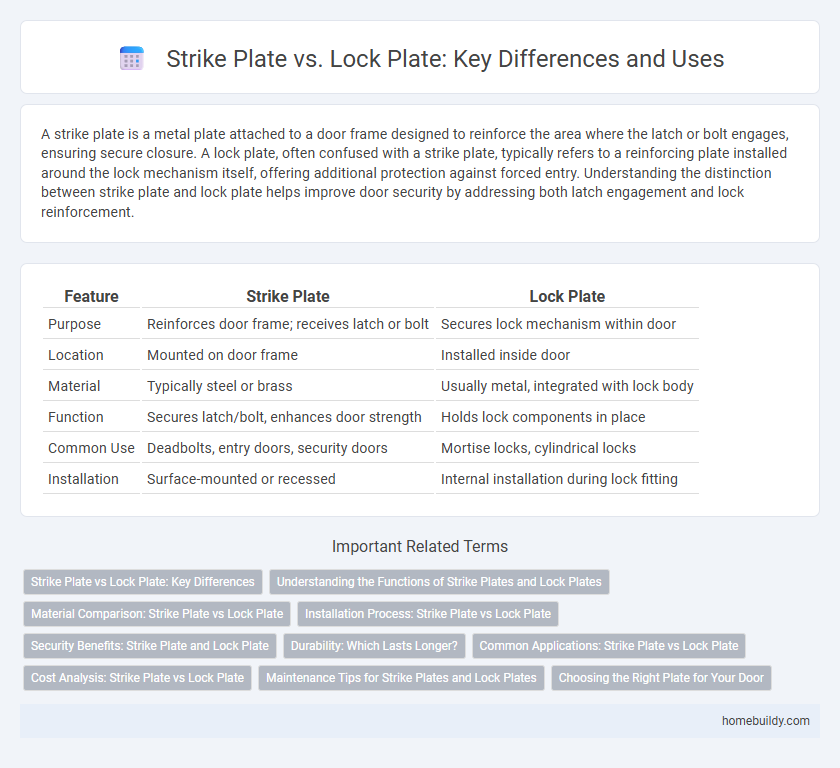A strike plate is a metal plate attached to a door frame designed to reinforce the area where the latch or bolt engages, ensuring secure closure. A lock plate, often confused with a strike plate, typically refers to a reinforcing plate installed around the lock mechanism itself, offering additional protection against forced entry. Understanding the distinction between strike plate and lock plate helps improve door security by addressing both latch engagement and lock reinforcement.
Table of Comparison
| Feature | Strike Plate | Lock Plate |
|---|---|---|
| Purpose | Reinforces door frame; receives latch or bolt | Secures lock mechanism within door |
| Location | Mounted on door frame | Installed inside door |
| Material | Typically steel or brass | Usually metal, integrated with lock body |
| Function | Secures latch/bolt, enhances door strength | Holds lock components in place |
| Common Use | Deadbolts, entry doors, security doors | Mortise locks, cylindrical locks |
| Installation | Surface-mounted or recessed | Internal installation during lock fitting |
Strike Plate vs Lock Plate: Key Differences
Strike plates and lock plates serve distinct roles in door security, with strike plates mounted on door frames to reinforce the latch or bolt area, enhancing resistance to forced entry. Lock plates, often integrated within the door hardware, provide additional support and alignment for locking mechanisms but do not bear the primary load during a forced attempt. Understanding these differences is crucial for selecting the appropriate hardware in residential and commercial security installations.
Understanding the Functions of Strike Plates and Lock Plates
Strike plates reinforce door frames by absorbing the impact and securing the latch bolt when the door is closed, ensuring proper alignment and enhanced security. Lock plates, typically integrated with locking mechanisms, provide additional reinforcement around the lock cylinder or deadbolt, preventing forced entry. Differentiating these components helps in selecting the right hardware for improved door security and durability.
Material Comparison: Strike Plate vs Lock Plate
Strike plates are typically made from hardened steel or brass, offering robust resistance against forced entry and wear, while lock plates may utilize softer metals or alloys to accommodate locking mechanisms. The durability of strike plates ensures long-term security by reinforcing door frames, contrasting with lock plates that prioritize integration with lock systems over material strength. Steel strike plates are often preferred in security applications due to their superior toughness compared to the often thinner, less resilient lock plates.
Installation Process: Strike Plate vs Lock Plate
The installation process of a strike plate involves securing the metal plate into the door frame to align with the latch bolt, typically requiring chiseling to create a recess for a flush fit. Lock plate installation focuses on integrating the entire locking mechanism's metal plate, often requiring precise alignment with both the door edge and frame, sometimes involving more complex adjustments for mortise locks. Accurate measurements and careful chiseling are critical in both installations to ensure smooth door operation and enhanced security.
Security Benefits: Strike Plate and Lock Plate
Strike plates and lock plates both enhance door security by reinforcing the point where the door latch engages the frame, but strike plates provide a larger metal surface that better resists kick-in attacks. High-quality strike plates made from hardened steel significantly reduce the risk of forced entry by distributing impact force more effectively than standard lock plates. Installing a strike plate with long screws anchored into the door frame's studs boosts the door's resilience against break-ins, offering superior security benefits compared to basic lock plates.
Durability: Which Lasts Longer?
Strike plates, typically crafted from hardened steel, offer superior durability compared to lock plates, which are often made from lighter materials. The robust construction of strike plates enhances resistance to repeated impacts and forced entry attempts, ensuring longer-lasting security. Therefore, strike plates generally outlast lock plates in high-traffic or high-stress applications due to their reinforced design.
Common Applications: Strike Plate vs Lock Plate
Strike plates are commonly installed in door jambs to reinforce the area where the latch or bolt extends, enhancing security and durability for residential and commercial doors. Lock plates, often integral to locking mechanisms, provide additional protection by covering lock cylinders or deadbolts, frequently used in high-security environments such as safes and secure entry points. While strike plates focus on latch engagement and frame strength, lock plates primarily safeguard the lock itself against tampering or forced entry.
Cost Analysis: Strike Plate vs Lock Plate
Strike plates generally offer a more cost-effective solution compared to lock plates, with prices typically ranging from $5 to $15 depending on material and design complexity. Lock plates, which integrate additional locking mechanisms, often incur higher manufacturing and installation costs, usually between $20 to $50. Choosing between strike plate and lock plate involves evaluating budget constraints against security needs, as strike plates provide basic reinforcement while lock plates deliver enhanced protection at a premium price.
Maintenance Tips for Strike Plates and Lock Plates
Maintaining strike plates involves regular inspection for alignment and tightening loose screws to ensure secure door locking. Lock plates require periodic cleaning to prevent dirt buildup and lubrication of moving parts to avoid rust and operational issues. Both strike plates and lock plates benefit from timely replacement if signs of wear or damage compromise door security and functionality.
Choosing the Right Plate for Your Door
A strike plate is specifically designed to reinforce the door frame where the latch or bolt extends, providing enhanced security and alignment for locks, while a lock plate covers the mortise lock area offering additional protection from forced entry. Choosing the right plate depends on door type, lock mechanism, and security needs; strike plates suit standard latch locks, whereas lock plates are ideal for mortise locks requiring more robust reinforcement. Opting for high-quality steel strike or lock plates with extended tabs and multiple screw holes increases durability and resistance against kick-ins.
strike plate vs lock plate Infographic

 homebuildy.com
homebuildy.com